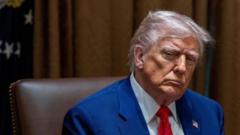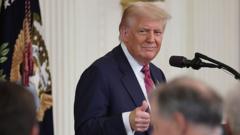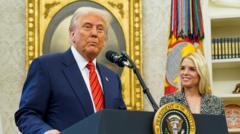A reflection on Trump's tariff goals outlines a mix of diplomatic negotiations, industrial challenges, and economic implications for American consumers.
Trump's Tariff Agenda: Successes and Setbacks

Trump's Tariff Agenda: Successes and Setbacks
Analyzing the outcomes of Trump's ambitious tariff strategy amidst a global economic reshaping.
Donald Trump's recent announcement of a sweeping tariff strategy aimed at remaking international trade relationships came with much fanfare. However, his declaration hit a snag as he paused the implementation of higher tariffs on a myriad of countries for 90 days, offsetting some of the potential upheaval within the global economic landscape. As questions about the tariff strategy's effectiveness arose, it brings us to evaluate five of Trump's pivotal trade goals and their current status.
1) Improved Trade Agreements
Trump positioned himself as a champion against what he termed "looting" by foreign nations. His tariff plan included imposing a flat 10% tariff universally and additional tariffs on countries he labeled as high offenders. While this strategy created immediate tension globally, it also led to diplomatic engagement, with over 75 world leaders reportedly reaching out to discuss trade matters. Notably, the U.S. is currently in discussions with South Korea and Japan. The urgency is now heightened as negotiators have a 90-day deadline, suggesting Trump could indeed achieve some concessions.
2) Revitalizing American Manufacturing
For years, Trump advocated for tariffs as a method to revive the American manufacturing sector. However, the ongoing instability in tariff implementations can disrupt companies' confidence in reshoring operations and investing in new domestic facilities. With unpredictable tariff changes, companies might wait before committing to significant expansions, keeping overall industrial growth in limbo.
3) Confronting China
Trump has placed significant emphasis on addressing perceived trading injustices from China, which he views as a catalyst for America's trade woes. Recent comments from White House officials reaffirm that confronting China remains a priority. Yet, this strategy carries substantial risks, particularly as it can lead to strained relations with key allies, which are essential in any economic contention with such a powerful adversary.
4) Generating Revenue
During his presidential campaign, Trump asserted that tariffs would generate wealth for the U.S., providing funds for tax reduction and debt tackling measures. If his proposed tariffs remain in place, they could accumulate significant revenue. Analysts estimate a 10% universal tariff could yield around $2 trillion over the decade, while tax cuts might burden the budget further.
5) Lowering Consumer Prices
Trump's grand vision included lowering costs for American consumers through increased domestic production. However, the consensus among economists suggests that imposing tariffs is likely to lead to increased prices for consumers. Estimated hikes could raise costs on average by $1,253 in the initial year of implementation, with lower-income groups feeling the most significant impacts.
As the dust settles on Trump's tariff ambitions, the landscape reveals both potential pathways for renegotiating trade agreements and cautionary tales regarding the economic repercussions for American businesses and households. The outcome of this strategic maneuver will ultimately determine its effectiveness in shaping a revitalized American economic future.























